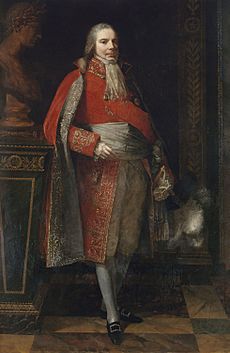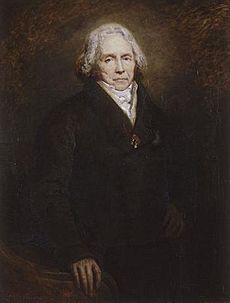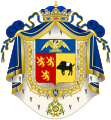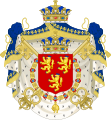Charles Maurice de Talleyrand-Périgord facts for kids
Quick facts for kids
Charles-Maurice de Talleyrand-Périgord
|
|||||||||
|---|---|---|---|---|---|---|---|---|---|
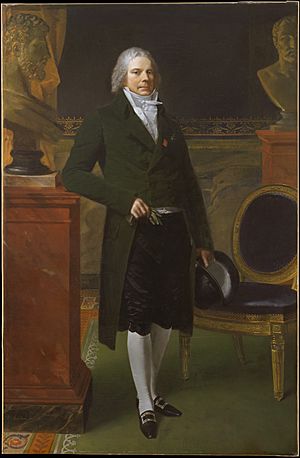
Portrait by Pierre-Paul Prud'hon (1817)
|
|||||||||
| Ambassador of France to the United Kingdom | |||||||||
| In office 6 September 1830 – 13 November 1834 |
|||||||||
| Appointed by | Louis Philippe I | ||||||||
| Preceded by | Pierre de Montmercy-Laval | ||||||||
| Succeeded by | Horace Sébastiani de La Porta | ||||||||
| Prime Minister of France | |||||||||
| In office 9 July 1815 – 26 September 1815 |
|||||||||
| Monarch | Louis XVIII | ||||||||
| Preceded by | Office established | ||||||||
| Succeeded by | Armand-Emmanuel de Vignerot du Plessis, Duc de Richelieu | ||||||||
| Minister of Foreign Affairs | |||||||||
| In office 13 May 1814 – 19 March 1815 |
|||||||||
| Monarch | Louis XVIII | ||||||||
| Preceded by | Antoine de Laforêt | ||||||||
| Succeeded by | Louis de Caulaincourt | ||||||||
| In office 22 November 1799 – 9 August 1807 |
|||||||||
| Monarch | Napoleon I (1804–1807) | ||||||||
| First Consul | Napoleon Bonaparte (1799–1804) | ||||||||
| Preceded by | Charles-Frédéric Reinhard | ||||||||
| Succeeded by | Jean-Baptiste de Nompère de Champagny | ||||||||
| In office 15 July 1797 – 20 July 1799 |
|||||||||
| Head of State | Directory | ||||||||
| Preceded by | Charles-François Delacroix | ||||||||
| Succeeded by | Charles-Frédéric Reinhard | ||||||||
| Member of the National Constituent Assembly | |||||||||
| In office 9 July 1789 – 30 September 1791 |
|||||||||
| Constituency | Autun | ||||||||
| Deputy to the Estates-General for the First Estate |
|||||||||
| In office 12 April 1789 – 9 July 1789 |
|||||||||
| Constituency | Autun | ||||||||
| Personal details | |||||||||
| Born | 2 February 1754 Paris, Kingdom of France |
||||||||
| Died | 17 May 1838 (aged 84) Paris, Kingdom of France |
||||||||
| Political party |
|
||||||||
| Education | Seminary of Saint-Sulpice | ||||||||
| Alma mater | University of Paris | ||||||||
| Profession | Clergyman, politician, diplomat | ||||||||
| Signature |  |
||||||||
|
|||||||||
Charles-Maurice de Talleyrand-Périgord (2 February 1754 – 17 May 1838) was a very important French diplomat and politician. He was also known as the 1st Prince of Benevento and later Prince of Talleyrand. He worked for many different French governments during a time of huge change in France.
Talleyrand started his career in the Church, becoming a bishop. But he soon moved into politics and diplomacy. He served under King Louis XVI, during the French Revolution, under Napoleon, and then under the restored kings Louis XVIII and Louis-Philippe. Even though some leaders didn't fully trust him, they found his skills very useful. His name became known for clever and sometimes tricky diplomacy.
He was Napoleon's main diplomat when France was winning many wars in Europe. However, Talleyrand often worked for peace to make sure France kept its gains. He helped make peace treaties with Austria in 1801 and with Britain in 1802. He later disagreed with Napoleon's constant wars. He even secretly worked with the Russian Tsar and Austrian minister to try and get a lasting peace. When Napoleon lost power in 1814, Talleyrand helped bring back the old royal family, the Bourbons. He played a big part at the Congress of Vienna (1814–1815), where he helped France get a good deal after the wars.
Historians have different opinions about Talleyrand. Some see him as one of the most skilled diplomats ever. Others think he was a "traitor" because he served so many different leaders and governments.
Contents
Early Life and Becoming a Bishop
Talleyrand was born in Paris into an old, noble family. His parents worked at the royal court. From a young age, Charles-Maurice had a limp. This meant he couldn't follow his father into a military career. So, he chose a career in the Church instead.
He hoped to become as important as his uncle, who was the Archbishop of Reims, a very rich and respected position. Talleyrand studied at a seminary and the Sorbonne. He read books by thinkers like Montesquieu and Voltaire, who questioned the old ways of government and the Church.
In 1779, at age 25, he became a priest. A year later, he got an important job helping manage the Church's properties in France. In 1788, he became the Bishop of Autun. He was known for being smart, but not very religious. During the French Revolution, he stopped being a bishop. In 1802, the Pope officially allowed him to leave the clergy.
Role in the French Revolution
Soon after becoming a bishop, Talleyrand joined the Estates-General of 1789. This was a meeting of representatives from different parts of French society. He represented the clergy (Church leaders). During the French Revolution, Talleyrand supported many changes that reduced the Church's power.
He helped write the Declaration of the Rights of Man and of the Citizen. This document stated the basic rights of all people. He also suggested that the government take control of Church properties. He even swore in new bishops who supported the revolutionary government, even though the Pope had punished him for this.
Talleyrand also pushed for public education. He wrote a long report suggesting a system of schools across France. Some of his ideas were used later. He also supported voting rights for Jewish people.

In 1792, Talleyrand went to London twice to try and prevent war between France and Britain. He met with British leaders, but his efforts failed. In September 1792, he left Paris for England just as violent events, known as the September massacres, began. In 1794, he was forced to leave Britain and went to the United States. He stayed there until 1796, working in banking and real estate.
After returning to France, he became the Foreign Minister in 1797. He saw a bright future for Napoleon during his military campaigns in Italy. Talleyrand and Napoleon became close. Talleyrand also helped Napoleon in a political takeover in 1797.
Working for Napoleon
Talleyrand played a key role in Napoleon's rise to power in 1799. This event, called the coup d'état of 18 Brumaire, created the French Consulate government. Talleyrand quickly became Napoleon's Foreign Minister. He often disagreed with Napoleon's plans for war, preferring peace.
He helped make the Treaty of Amiens in 1802, which brought a short period of peace. Talleyrand believed France had grown enough and should focus on keeping peace.
Talleyrand was also involved in the "German mediatization." This was when many small German states were reorganized. Rulers who lost land on one side of the Rhine River were given new lands on the other side. Many rulers paid bribes to get better deals, and Talleyrand made a lot of money from this. This event helped break up the old Holy Roman Empire.
In 1804, Napoleon gave Talleyrand the important title of Grand Chamberlain of the French Empire. In 1806, he was made the Prince of Benevento in Italy. Talleyrand did not like how harshly Austria and Prussia were treated in peace treaties after Napoleon's victories.
Changing Sides
Talleyrand grew tired of working for Napoleon, as he no longer trusted the emperor's decisions. He resigned as foreign minister in 1807. He disagreed with Napoleon's invasion of Spain, which started a long war.
At a meeting in 1808, Talleyrand secretly advised Tsar Alexander of Russia. He told the Tsar not to agree to Napoleon's plans against Austria. Talleyrand believed Napoleon's constant wars would eventually destroy the French Empire.
After 1807, Talleyrand started taking money from countries like Austria and Russia. In return, he shared Napoleon's secrets. Napoleon found out about some of Talleyrand's actions and was very angry. He publicly scolded Talleyrand.
Talleyrand also criticized Napoleon's invasion of Russia in 1812. When Napoleon's power began to fade in 1814, Talleyrand saw an opportunity. After Paris fell to the Allied forces, Talleyrand hosted the Tsar. He convinced him that bringing back the old royal family (the Bourbons) was the best way to bring stability to France.
On April 1, 1814, Talleyrand led the French Senate in forming a temporary government. The Senate officially removed Napoleon from power. By April 11, they had agreed to a treaty and a new constitution to bring back the Bourbon monarchy.
Bourbon Restoration and Later Life
When Louis XVIII became king in April 1814, Talleyrand was a key person in bringing back the House of Bourbon. He was the main French negotiator at the Congress of Vienna, a big meeting of European powers. Thanks to his skills, the peace treaty for France was surprisingly fair.
At first, only four powerful countries (Austria, Britain, Prussia, and Russia) were making decisions at the Congress. Talleyrand fought for France and smaller countries to have a say. He managed to get France included in the main discussions. He used the disagreements between Russia and Prussia, and Austria and Britain, to France's advantage.
On January 3, 1815, Talleyrand, along with Austria and Britain, signed a secret agreement. They promised to work together to protect security and independence against Russia and Prussia. This helped France return to its 1792 borders without having to pay huge amounts of money. Many historians saw Talleyrand's diplomacy as a big success for France at the time.
When Napoleon returned to France in 1815 for a short period (the Hundred Days), it was a setback for Talleyrand's diplomatic work. The second peace treaty for France was much tougher. Talleyrand resigned as foreign minister in September 1815 because he disagreed with the harsh terms. King Louis XVIII then gave him a ceremonial role as Grand Chamberlain of France. For the next 15 years, he mostly stayed out of active politics.
In 1829, Talleyrand helped start a newspaper called National. This newspaper supported King Louis-Philippe. After Louis-Philippe became king in 1830, Talleyrand became the ambassador to the United Kingdom. He worked to strengthen Louis-Philippe's government. He also played a vital role in creating the new independent Kingdom of Belgium. In 1834, he signed a treaty that brought France, Britain, Spain, and Portugal together as allies.
Talleyrand retired from his ambassador role in 1834. He spent his time at his Château de Valençay and in Paris. His health got worse, and he used a special armchair with wheels. He worried about how people would remember him. He ordered his autobiography, the Memoirs, to be published 30 years after his death.
Near the end of his life, Talleyrand became interested in the Catholic Church again. He died on May 17, 1838, and was buried near his castle. Today, the phrase "he is a Talleyrand" can mean someone who is a very clever diplomat or a politician who changes sides often.
Private Life
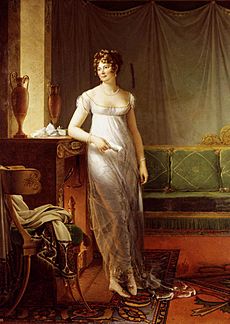
Talleyrand was known for enjoying life and having many relationships. He did not have any official children. However, some historians believe he might have had an illegitimate son, Charles Joseph, comte de Flahaut.
Noble women were important in Talleyrand's political strategies. His friend Germaine de Staël helped him greatly, especially in getting him back to France from his exile and becoming foreign minister. He lived with Catherine Worlée, whom he later married in 1802 after Napoleon insisted. Later, he separated from Catherine.
Talleyrand was known for accepting payments for his state duties. For example, during the reorganization of German states, many rulers paid him to help them keep or gain land. This was a common practice at the time. After Napoleon's defeat, Talleyrand was given the title of Duke of Talleyrand with the style "Prince de Talleyrand" for life.
Talleyrand was a great conversationalist, loved good food, and was a wine expert. He owned the Château de Valençay, which Napoleon asked him to buy for hosting foreign guests. He lived there until his death. He even had a famous chef, Marie-Antoine Carême, who was known as the "chef of kings."
Some people have called Talleyrand a traitor because he served many different governments. However, some historians argue that he was always serving France itself, no matter who was in power.
Honors
- Pair de France (a high noble title)
- Knight Grand Cross in the Legion of Honour (a top French award)
- Knight of the Order of the Holy Spirit
- Knight of the Order of the Golden Fleece of Spain
- Knight Grand Cross of the Order of St. Stephen of Hungary
- Knight Grand Cross of the Order of Saint Andrew
- Knight Grand Cross of the Order of the Red Eagle
- Knight Grand Cross of the Order of the Black Eagle
- Knight of the Order of the Elephant
- Knight of the Order of Saint Hubert
- Knight Grand Cross of the Order of the Sun
- Knight Grand Cross of the Order of the Crown of Saxony
- Member of the American Philosophical Society (elected 1796)
Interesting Stories
- In 1797, a rumor spread that the King of Great Britain had died. A banker, hoping to make money, asked Talleyrand for information. Talleyrand replied, "Some say the King of England is dead; others, that he is not dead: for my own part, I believe neither the one nor the other. I tell you this in confidence, but I rely on your discretion."
- The Spanish Ambassador complained to Talleyrand that the seals on his diplomatic letters had been broken. Talleyrand replied, "I shall wager I can guess how the thing happened. I am convinced your despatch was opened by someone who desired to know what was inside."
- Talleyrand was very afraid of falling out of bed while sleeping. To prevent this, his mattresses were made with a dip in the middle. He also wore fourteen cotton nightcaps at once, held together by a "tiara."
- After the Allies took Paris, the Prussian General Blücher wanted to destroy the Pont d'Iéna bridge, named after a French victory. Talleyrand wrote to Tsar Alexander, who was in Paris. He asked the Tsar to officially rename and open the bridge himself. The Tsar agreed, so Blücher couldn't destroy a bridge that an ally had just honored. The bridge's name was later changed back.
Images for kids
-
Arms of Talleyrand under the Napoleonic Empire
-
Arms of Talleyrand under the Bourbon Restoration
-
Empire style state bed (lit de parade) made for Talleyrand, c. 1805
See also
 In Spanish: Charles Maurice de Talleyrand para niños
In Spanish: Charles Maurice de Talleyrand para niños


